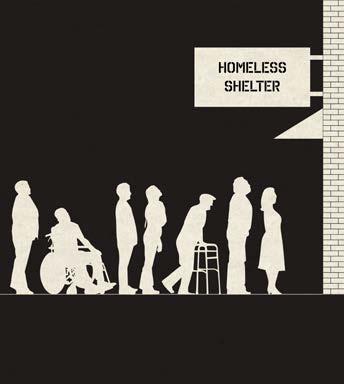
8 minute read
News pages 3 to
from 19 January 2022
Shelters struggling to retain staff, volunteers
Testing delays and anxiety cause shortages, gaps in services
NEWS
Colton McKillop, staff The ongoing surge of Omicron cases has some Winnipeg homeless shelters struggling to retain staff and recruit volunteers to operate their services.
Staffing shortages have been partly caused by employees testing positive or being a close contact of a confirmed COVID case and long wait times for tests, while volunteers are hesitant to visit some missions in the midst of the rapid spread of the highly infectious Omicron variant.
Peter McMullen, director of Lighthouse Mission, said the organization started last week with less staff and volunteers than needed and saw this number decline further over the course of the week.
“So [we had] seven on Monday, six on Wednesday and then five on Thursday,” he explained.
“In order to operate effectively we need […] a total of about eight [staff and volunteers] minimum.”
Lighthouse Mission has been forced to assign roles normally performed by volunteers to paid employees, further stretching their resources.
The staffing shortage, as well as increased demand for services during the pandemic, has created a “bottleneck” for accessing services, with some detox facilities facing five- to six-week waiting lists.
“What we’re doing at the Lighthouse right now is we’re fundraising to open a detox right on the facility,” said McMullen.
The organization is aiming to raise $2.5 million with the goal of opening a dozen new detox beds as soon as this year.
Testing backlogs and changes to PCR eligibility have caused confusion among shelter workers.
Previously, shelter workers could get a test and expect results within a day or two, but with PCR tests limited to a few categories of people — including the homeless — employees are left wondering whether they still qualify.
Pandemic requires “strategy and adaptation”
Kris Clemens, manager of communications and community relations with End Homelessness Winnipeg, said even before Omicron, the pandemic already required “a lot of strategy and adaptation” from shelters.
“We’ve been told throughout this entire pandemic to stay home, and yet we have thousands of people in our city that don’t have a permanent or safe place to call home. So, those individuals are, of course, at particular risk of contracting COVID-19,” she said.
“Many of the services [for homeless people] have traditionally been deployed in group and congregate settings, so our entire homelessness service sector is oriented to providing supports to groups of people in person and all of that is advised against for COVID prevention.”
Main Street Project’s 39 COVID isolation units have been full twice in the past few weeks, and although their capacity has not yet been overwhelmed, shelter employees worry there will not be enough space if there is an outbreak in one of their bigger shelters.
End Homelessness Winnipeg has been working to track the situation and foster communication between homeless shelters and advocacy groups about the availability of various services on any given day.
The Omicron wave coincided with bitterly cold weather, with wind chills of -40 C or lower, causing shelters to see an increase in incidents of frostbite, including one case where a man’s fingers turned black.
Homeless people have faced additional difficulties escaping the cold as the restaurants and coffee shops they would have previously taken refuge in now require proof of vaccination to enter — a tricky barrier to overcome for those without a permanent address to mail vaccination cards to.
Low-income housing needed, say advocates
Clemens said despite the “urgent need” to build more low-income housing units in order to resolve the housing crisis, the city has “actually lost units overall.”
“So, we’re going backwards on the creation of low-income housing units at a time when we urgently need to go forward in order to provide people with safe places to isolate if they get sick,” she said.
“Because of this housing crisis, people have few other options besides these congregate emergency shelters where, of course, the risks are much higher for getting COVID, even with robust safety measures and collaborations with health [authorities].”
The federal government announced earlier this month it would invest $12.7 million toward three new affordable housing projects targeted at Indigenous people, women and children escaping domestic abuse and LGBTTQ* people. Clemens said this announcement is “good news” but only a “small step.”
“The 59 units that will be created through this recently announced funding are nowhere near the 23,000 new housing units needed in Manitoba to meet the Canadian average of homes per capita,” she said.
“Canada’s available housing per capita is already far lower than any other G7 country.”
Clemens said governments need to “shift their focus” when it comes to homelessness.
staff Dallin Chicoine / graphic /
— Kris Clemens, End Homlessness Winnipeg manager of communications and community relations
“[We should move] from thinking about homelessness being addressed through emergency shelters to addressing the gaps in our housing continuum and providing enough low-income as well as low-barrier and supportive housing options, so that people have safe places to call home to isolate if they’re sick and to be safe, in this pandemic and also afterward.”
Psychotropic drug use among kids affected by pandemic
Anti-depressant use increases, stimulant use declines
RESEARCH & TECHNOLOGY
Michael Campbell, staff Christine Leong, an assistant professor in the college of pharmacy, is the first author of a recently published research letter in JAMA Pediatrics, published by the American Medical Association, comparing psychotropic drug use among children and adolescents prior to and during the COVID-19 pandemic. Psychotropic drugs are any medication that can be used to treat a psychiatric condition. Leong published the letter alongside six other researchers from the University of Manitoba.

staff Mohammad Arsalan Saeed / photo /
Leong graduated from the University of Manitoba with a bachelor of science degree and the University of Toronto with a doctorate in pharmacy, before returning to Winnipeg as a hospital pharmacist at the Health Sciences Centre and later as an assistant professor.
The study found a nearly twofold decrease in stimulant and anxiolytic or sedative-hypnotic use among children in a Manitoba population immediately following the public health closures in the spring in 2020. However, the study also found a marked increase in antidepressant use near the end of 2020.
“The majority of the stimulant use represents ADHD medications, and so we did expect that finding,” Leong said.
The researchers explain the decrease in stimulant use among children as in part due to school closures and restrictions on in-person physician visits. Leong said in the case of stimulant use, there is a decrease in prescriptions being filled by patients and fewer new prescriptions being made.
Leong explained during the summer months when school is out, there is a “drug holiday” of reduced usage among people who take ADHD medications, and it could be the case that this established phenomenon is occurring during pandemic-caused school closures as well. This could explain the decrease in prescriptions being filled, while fewer opportunities for in-person physician visits may why explain fewer prescriptions are being made.
“It’s difficult to pinpoint exactly what could be causing the rise in antidepressant use,” Leong said.
“Antidepressants can be used for both anxiety or depression, and so it’s hard to decipher if it’s one or the other.”
The increase in antidepressant use could be explained by an increase in new-onset depression or anxiety among children in Manitoba in 2020, the researchers explained. The hypothesis that public health closures and social isolation may have led to an increase of depression or anxiety supports more inquiry into the health effects of pandemic measures.
Leong is interested in following up on this study with an analysis of the 2021 data to see if the partial re-opening of certain activities affected the use of psychotropic drugs. Ultimately, it will be impossible to know the full extent of how the pandemic affected psychotropic drug use in Manitoba until the pandemic is over.
Leong suggested that if there is a significant rise in anxiety and depression among children, then policy makers should take into account the risks versus the benefits of things like school closures.
“During this time, I think it’s just an additional piece of information that could be useful in terms of improving the mental health of children,” Leong said. research on population-based health outcomes because of their access to data.
“We use the administrative data from the Manitoba Centre for Health Policy,” Leong said.
“What’s unique is that in Manitoba we have pretty much access to data not restricted by age or income or drug coverage, whereas there is some data that’s available in other jurisdictions [where] you’ll only have patients that are of a certain age or are able to be covered.”
This unrestricted data allows researchers to examine target populations to reveal underlying patterns.
The study was funded by Research Manitoba’s COVID-19 Rapid Response Grant Competition. In total, the University of Manitoba received $3.8 million in research funding from the competition. psychiatric pharmacy will now turn to a pilot program to make mental health resources more accessible through pharmacists. Leong has received a grant from the Canadian Foundation for Pharmacy’s 2021 Innovation Fund to support a study examining the impact of mental health first-aid training for pharmacists, hypothesizing that pharmacists who are properly trained in mental health first-aid will be better able to assist their patients. The study will train 25 pharmacists and collect data to determine if the training improves care and reduces stigma surrounding mental health.
“I do hope that patients will feel comfortable enough to speak to a pharmacist and that pharmacists would be well-prepared to direct them to the services that they need,” Leong said.




